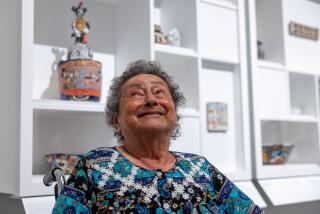ARTIST PLANTS HIS STYLE WITH ROOTS IN EAST TEXAS
- Share via
Think of James Surls as a self-styled tree. His roots tunnel deep into the piney woods of eastern Texas; his branches stretch around the world and into the universe. Gathering inspiration from everything within his reach and from fantasies that spin off into space, he recycles his gleanings into art that’s part earthly experience, part cosmic dream. “If you are a psychological swimmer and you bring back proof of where you’ve been, then you get to be an artist,” says Surls, whose latest work is the subject of a solo exhibition at L.A. Louver Gallery in Venice.
“I consider myself as having gone off the planet, but the bugbear is the proof,” he continues, readily acknowledging that he’s not averse to inventing things. “I have to try to make your picture of what I’ve seen correspond to mine through the images I make and the titles I give them.”
The pristine gallery (at 77 Market St.) is charged with the vaguely spooky presence of Surls’ mental pictures. Materialized as wiry line drawings and spiky, rough-hewn wood sculpture, his anthropomorphic visions bear such provocative names as “Man Angel,” “Hurt Flower” and “Talk to the Devil.” Simultaneously friendly and scary, they twist and squirm, sprout petals or human parts as they dangle from the ceiling, hang on walls or grow from the floor.
The centerpiece is “On Being in the Wind,” a massive wood sculpture that nearly grazes the ceiling. This work is about “prevailing wind”--the “constant pressure” that forms all growing things, according to the 42-year-old artist. With a tree growing from the roof of a chunky house and a human form sprouting in the branches, this sculpture carries out a trademark theme: the metamorphosis of one thing becoming another.
His is a world in flux and a sphere balanced by angels and devils. He constructs benign flower abstractions with charred wood petals protruding from spirals of pipe, but he also concocts terrifying characters that epitomize “the fear factor.” “Fear used to be the growl in the night that could eat you,” the artist explains. “We measure it today in megatonnage.”
Confessing to a practice of switching from gentle work to angry anti-war pieces, Surls says, “I don’t want to be a sweet, insipid sugar ball, and I don’t want to be a gloom-and-doomer, either. It takes balance to be a whole person.”
A down-to-earth artist who only talks as if his head is in the clouds, Surls has reached the enviable position of having prosperity, critical acclaim and a satisfying family life. Though often incorrectly relegated to the ranks of Texas regionalists, he is a major national figure, recognized in dozens of one-man exhibitions and a traveling retrospective seen recently in La Jolla.
His success seems the result of finding a niche that authentically fits him. But, as he tells it, settling into his present condition wasn’t easy. After receiving his MFA degree from Cranbrook Academy of Art in 1969, his fledgling career hit the skids with the realization that “I was just making art that sat there and looked good.” “I was on the wrong track with the wrong stuff at the wrong time in the wrong place,” Surls says. He had been working on monumental metal abstractions in the belief that “the process was the art” and “to make it better you simply had to make it bigger.”
“It’s a stark thing when all of a sudden you don’t believe in what you’ve been working on for years,” he recalls. “I grabbed my stuff, went back to Texas, lived in a grubby little apartment in Dallas, did welding in a boiler room and watched television.” He also sold cars and life insurance while looking for his aesthetic identity.
“It was a time of down, but I kept looking for a ray of light,” Surls says. “I started looking for myself in my early memories and then drew pictures of them.” The memories took him back to “a happy childhood” in his native eastern Texas and to a point of building his own “visual alphabet.”
Some of the symbols he devised are still visible in current work: needles representing female figures, males as viny lines penetrating the needles’ eyes, straight lines for rational thought, birds for spirit figures, eyes for human potential.
Surls also left metal for wood, the material that surrounded him in the piney woods and provided a living for his carpenter father. Today the artist says he spends “an enormous amount of time looking for a left leg or a torso” for his sculptures while meandering in the forest.
Surls is a champion of “art as a healing force” who advises that “more people could be artists if they were willing to play as adults.” He lives on 32 acres of land in Splendora (40 miles east of Houston) with his wife, artist Charmaine Locke, and four of his six daughters. “I don’t love being from Texas,” Surls says, “but I decided I didn’t want to move around anymore. This is where I will live forever. When you give yourself a sense of belonging to a place, you can plan ahead and clear out your thinking. Now all the things that junk up my system--like the baby crying--are there by choice.”
More to Read
The biggest entertainment stories
Get our big stories about Hollywood, film, television, music, arts, culture and more right in your inbox as soon as they publish.
You may occasionally receive promotional content from the Los Angeles Times.










